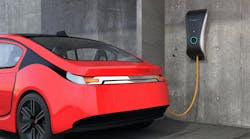It looks like we can finally expect some solid but not spectacular growth. The residential market is rebounding and most construction economists have pegged the all-important nonresidential market for 4% to 8% growth in 2013. Because the stage is set for a much-improved economic climate over the next two years, in this month's cover story on page 14, “10 Trends that Will Shake the Industry,” EW's editors made their picks for the market opportunities and technological trends that will have the most impact on the electrical market during this rebound. Here are three more economic trends that will produce sales opportunities down the road.
Dozens of data centers are being built to keep up with an explosion in data. You don't have to look any further than that smartphone in your pocket to realize we all produce an enormous amount of data that has to be stored somewhere. According to Digital Realty Trust, a real estate investment trust (REIT) that owns 110 data centers with a combined 21 million square feet of rentable space, for the past few years global internet traffic has grown at a 29% compounded annual growth rate. Google, Apple, Facebook and Amazon are building enormous data centers to store their users' tweets, searches, images, posts, music, videos and other data.
For instance, according to www.datacenterknowledge.com, Google spent $1 billion on its data center operations in the fourth quarter of 2012 alone, including $600 million on an expansion of its campus in Berkeley County, S.C., and $200 million on its existing facilities in Council Bluffs, Iowa. Apple recently built enormous data centers in North Carolina and Oregon, and last summer news broke that it plans to invest $1 billion over the next 10 years in a data center now under construction on a 36-acre property in Reno, Nev. These facilities are loaded with electrical construction materials, UPS backup systems, generators and all sorts of low-voltage cabling for security, networks and controls.
Port facilities are being renovated to handle a new class of super-sized cargo ships. The global shipping industry is getting ready to enter the age of the super-ship, and once the expansion of the Panama Canal is complete in 2015, the behemoths will be sailing to East Coast ports like New York/New Jersey; Baltimore; Norfolk, Va.; Charleston, S.C.; and Savannah, Ga.; Houston and Mobile, Ala., on the Gulf Coast; and the biggest port in the country, Los Angeles-Long Beach, which is now undergoing a $3 billion renovation. The California port competes with the East Coast ports for business, and these renovations will give shipping companies from Pacific Rim countries sailing the new container vessels direct access to Southern California and the West Coast. All of these ports are busy preparing for the arrival of the mega-ships by dredging their harbors, raising bridges, improving docks and installing new cranes.
These renovations can translate directly into dollars for a local economy. Airbus recently inked a deal for a $600 million aircraft assembly plant in Mobile in part because of the city's newly renovated port. And according to an article in Real Estate Issues, in 2010 Boeing began building a plant in Charleston, S.C., because of that city's growing port.
This construction is good business for distributors near these port cities, and it may have fueled at least one acquisition. Last year, Turtle & Hughes Inc., Linden, N.J., acquired automation specialist Mag-Trol Long Beach Inc., Long Beach, Calif. Mag-Trol focuses on harbor applications.
The construction of more modern intermodal facilities will allow faster dock-to-rail transfers. This trend is related to the previous one, and will link the new port facilities to the nation's network of rail facilities, giving trucking companies better access to rail freight for local delivery. According to a post on www.marketline.com, the port of Los Angeles recently began construction of a $137 million intermodal storage facility that will link to the port directly to an existing California freight line.
On the East Coast, the $850 million National Gateway project is a public-private partnership with the CSX freight line that will improve rail traffic throughout the nation by creating a new double-stacked rail corridor that connects East Coast ports to markets in the Midwest and the South. Intermodal facilities are being built or renovated all over the United States, and they often attract business such as trucking companies and other companies that want to unload freight locally and truck it to customers.










